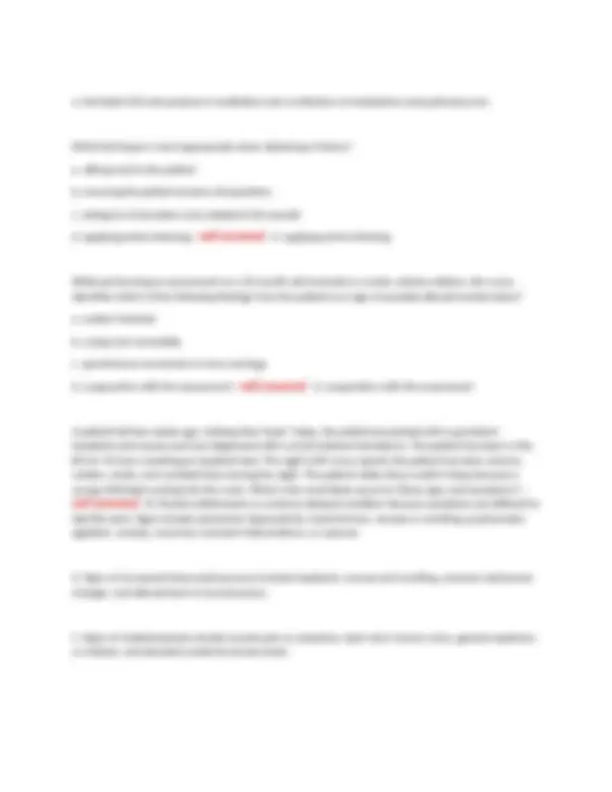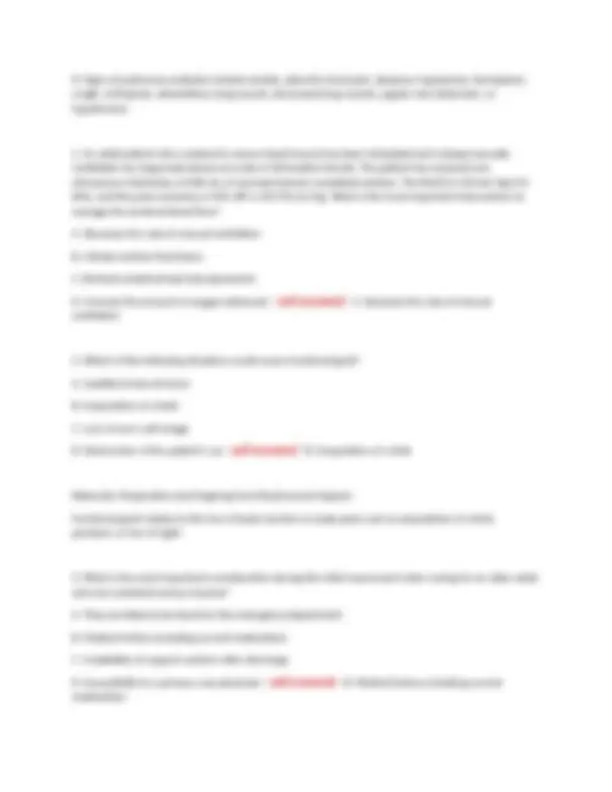

































Study with the several resources on Docsity

Earn points by helping other students or get them with a premium plan


Prepare for your exams
Study with the several resources on Docsity

Earn points to download
Earn points by helping other students or get them with a premium plan
Community
Ask the community for help and clear up your study doubts
Discover the best universities in your country according to Docsity users
Free resources
Download our free guides on studying techniques, anxiety management strategies, and thesis advice from Docsity tutors
TNCC 9 TH EDITION FINAL ACTUAL EXAM NEWEST VERSION 2025/2026 QUESTION AND CORRECT DETAILED VERIFIED ANSWERS FROM VERIFIED SOURCES RATED A+ GRADE.
Typology: Exams
1 / 39

This page cannot be seen from the preview
Don't miss anything!
































You are caring for a patient who was thrown from a bike and was not wearing a helmet. While performing the head-to-toe assessment, you note clear drainage from the right ear. Which of the following is the most appropriate next step? A. Clean the ear with a cotton-tipped applicator. B. Pack the ear with gauze. C. Notify the physician D. Document and continue the exam. - well answered C. Notify the physician A patient is brought to the emergency department of a rural hospital following a high-speed motor vehicle collision. When significant abdominal and pelvic injuries are noted in the primary survey, what is the priority intervention? A. Initiate transfer to a trauma center B. Attempt family notification C. Obtain additional imaging studies D. Place an indwelling urinary catheter - well answered A. Initiate transfer to a trauma center An adult who fell from a second story roof is brought to the emergency department by private vehicle. The patient is confused with unlabored respirations and has strong, palpable radial pulses. There is an open wound in proximity to an obvious deformity of the left lower extremity. What is the priority intervention? A. Initiate cervical spine stabilization
B. Apply a splint to the lower extremity C. Put the patient on portable oxygen. D. Log roll the patient onto a spine board - well answered A. Initiate cervical spine stabilization An adult patient who sustained a severe head trauma has been intubated and is being manually ventilated via a bag-mask device at a rate of 18 breaths/minute. The patient has received one intravenous fluid bolus of 500 mL of warmed isotonic crystalloid solution. The PaCO2 is 30 mm Hg (4. kPa), and the pulse oximetry is 92%. BP is 142/70 mm Hg. What is the most important intervention to manage the cerebral blood flow? A. Decrease the rate of manual ventilation. B. Initiate another fluid bolus. C. Recheck endotracheal tube placement. D. Increase the amount of oxygen delivered. - well answered A. Decrease the rate of manual ventilation. An adult patient is brought to the emergency department following a vehicle "roll-over" with prolonged extrication. Assessment reveals swelling and bruising to the right proximal thigh and a weak pedal pulse. Skin is pale, cool, and moist. What is the most appropriate initial intervention? A. Application of a tourniquet to the affected extremity B. Application of a pelvic binder C. Fluid resuscitation to maintain a urine output of 0.5 mL/kg/hour D. Oxygen to maintain the ETCO2 between 30-35 mm Hg (3.9-4.6 kPa) - well answered B. Application of a pelvic binder An adult arrives at the emergency department with superficial burns to the extremities following a house fire. The patient is reporting a headache with nausea and is drowsy and confused. What is the most likely cause of these symptoms? A. Capillary leak syndrome B. Rhabdomyolysis
An adult was thrown against a concrete wall during a factory explosion and sustained a femur fracture, liver laceration, and a small subdural hematoma. These injuries most likely occurred during what level of blast trauma? A.Primary B.Secondary C.Tertiary D.Quaternary - well answered A patient presents to the emergency department with a degloving injury involving the entire forearm. What should the nurse consider when planning care for a patient with this injury? A.Wound edges can be easily approximated for suturing. B.Surgical intervention will be needed C.Extent of tissue damage does not affect potential limb salvage D.Only soft tissue has been damaged - well answered A 35-year-old male presents with facial trauma after being struck in the face with a baseball. A teardrop- shaped left pupil is noted on exam. What type of injury is suspected? A.Oculomotor nerve palsy B.Globe rupture C.Retrobulbar hematoma D.Retinal detachment - well answered A driver involved in a high-speed motor vehicle collision arrives in the emergency department. The vehicle's air-bag failed to deploy. The patient is drowsy but arousable and complaining of chest pain with ecchymosis noted to the chest. The patient is tachycardic and hypotensive with no evidence of uncontrolled bleeding. Cardiac monitor shows premature ventricular contractions. Which of the following is the most appropriate intervention for this patient? A.Rapid fluid boluses
B.Tranexamic acid administration C.Inotropic support D.Epinephrine administration - well answered A trauma patient who is 30-weeks pregnant arrives at the emergency department following a motor vehicle collision. Which normal physiologic change should be considered when assessing ventilatory status? A.Increased functional reserve capacity B.Increased oxygen consumption C.Decreased minute ventilation D.Slower desaturation rates with apnea - well answered A trauma patient is being resuscitated in the emergency department when the radiology staff notifies the charge nurse that the computed tomography (CT) scanner will be out of service for several hours. The team gathers to plan accordingly. Which of the following terms best describes this trauma team's communication? A.Brief B.Closed-loop C.Debrief D.Huddle - well answered An adult pedestrian was struck on the right side by a sport utility vehicle traveling at 40 mph. The patient is awake and alert and the right leg is shortened. Following initial resuscitation with fluids, the patient remains hypotensive. What would be the priority intervention? A.Send blood for type and crossmatch B.Apply a pelvic binder C.Prepare the patient for surgery D.Insert a urinary catheter - well answered
B.Ensuring the patient answers all the questions. C.Asking for information only related to the assault. D.Using direct quotes to record information. - well answered A trauma patient is being held in the emergency department because there are no available inpatient beds. The patient sustained a femur fracture and required multiple blood products. The patient now has blood oozing from abrasions, IV sites, the nose, and gums. What condition is most consistent with these findings? A.Rhabdomyolysis B.Fat embolism C.Disseminated intravascular coagulopathy D.Multiple organ dysfunctions syndrome - well answered An unconscious patient arrives following a motor vehicle collision. The patient is on a backboard with a cervical collar in place and one intravenous line running. Respirations are shallow and there is active brisk bleeding from a large leg wound. What is the priority intervention for this patient? A.Check for a patent airway B.Control the bleeding C.Start a second intravenous line D.Ventilate with a bag-mask device - well answered A restrained driver involved in a motor vehicle collision is brought to the emergency department with abdominal, pelvic, and bilateral lower extremity pain. Vital signs are BP 114/78 mm Hg, HR 98 beats/minute, RR 22 breaths/minute. A FAST exam is negative for fluid in the abdominal and peritoneal cavities. Which of the following should the nurse anticipate? A.Diagnostic peritoneal lavage B.Angiography C.Operative management D.Serial abdominal assessments - well answered
A patient is brought to the emergency department following a snowmobile crash with prolonged exposure time prior to transport. The patient is confused. Vital signs are BP 96/54 mm Hg, HR 114 beats/minute, RR 24 breaths/minute, T 34.6oC (94.2oF) and an SpO2 of 90% on oxygen at 15L per non- rebreather mask. Other findings include ETCO2 24, serum lactate of 6 mmol/L, and a pH of 6.8. Based on these findings, what is the most appropriate intervention? A.Initiate warming measures B.Titrate oxygen to 6 L per nasal cannula C.Bolus with 500 mL isotonic crystalloids D.Vigorously massage the extremities - well answered A patient presents with chest pain and shortness of breath following a motor vehicle collision. An electrocardiogram shows sinus tachycardia and ischemic changes with an elevated troponin. The nurse should be highly suspicious for which injury? A.Cardiac tamponade B.Blunt cardiac injury C.Aortic disruption D.Pulmonary contusion - well answered What intravascular solution is most commonly used for patients who have sustained burns? A.Lactated Ringer's B.Normal saline C.D5 / normal saline D.Hypertonic saline - well answered A patient has been diagnosed with an incomplete spinal cord injury at L1. Which finding would indicate sacral sparing?
A patient arrives with a 3-inch laceration to their forearm from a tree branch. Which of the following methods will the nurse use to remove small pieces of bark and debris from the wound? A.Low-pressure irrigation B.High-pressure irrigation C.Scrubbing with normal saline D.Scrubbing with tap water - well answered An adult patient was a restrained passenger involved in a high-speed motor vehicle collision. The patient complained of generalized abdominal and left leg pain. A FAST exam was negative for fluid in the abdominal cavity. While awaiting inpatient bed placement, the patient develops increased abdominal pain with rebound tenderness, fever, and an elevated white blood cell count. These findings are most consistent with an injury to which organ? A.Spleen B.Kidney C.Small bowel D.Liver - well answered A trauma patient involved in a fall from 25 feet has a traumatic brain injury, three anterior rib fractures on the right side, a small pneumothorax on the right, and a Grade III liver injury. The patient was intubated and placed on a ventilator with PEEP. Chest tube was deferred at this time. Upon reassessment, which finding is most concerning? A.Severely diminished breath sounds on the right B.Guarding in the right upper quadrant C.Ecchymosis in the right upper quadrant D.Crepitus to the right chest - well answered A patient has uncontrolled bleeding from a wound to his right upper extremity. What is the priority intervention?
A.Initiate two intravenous access sites B.Place the patient on supplemental oxygen C.Apply direct pressure to the wound D.Use a tourniquet to control the bleeding - well answered What position optimizes ventilation in the obese patient with a lumbar fracture? A.Reverse Trendelenburg B.Supine C.Prone D.Fowler's - well answered Based on fall mechanism, which patient warrants prehospital transfer to a trauma center? A.A 35-year-old lands on a wooden porch from an 8-foot ladder B.A 2-year-old lands on grass from a second-story balcony C.A 14-year-old forcefully pushed onto cement from standing D.A 50-year-old lands on a carpeted floor after tripping - well answered
D. During the circulation assessment - well answered B. After removal of clothing Rationale: Musculoskeletal and Wounds\Burns Some fluid will be given initially, but an accurate fluid total is based on percentage of total body surface area which requires a good skin assessment and is calculated after clothing is removed.
C. It is infrequently associated with substance abuse. D. Those experiencing human trafficking rarely self-disclose. - well answered D. Those experiencing human trafficking rarely self-disclose.
C. Needle decompression D. Airway and ventilation support - well answered D. Airway and ventilation support
Rationale: Head and Torso Trauma\Abdominal and Pelvic Trauma Liver injuries are associated with right, lower rib fractures. They also can present with tenderness, guarding, or rigidity in the right upper quadrant, along with ecchymosis of the right upper quadrant or around the umbilicus, known as Cullen's sign
A patient with a spinal cord injuryt at C5 is being cared for in the emergency department while awaiting transport to a trauma center. Which of the following represents the highest priority for ongoing assessment and management for this patient? a. maintain adequate respiratory status b. administer balanced fluid resucscitation c. perform serial assessment of neurological function d. maintain core temperature - well answered A. Maintain respiratory status- injuries at C3-C5 can cause loss of phrenic nerve function, resulting in a paralyzed diaphragm and inability to breathe. Maintenance of respiratory function is the highest priority. What is the best position for maintaining an open airway in the obese patient? a. Prone b. Supine c. Reverse trendelenburg d. right lateral recumbent - well answered c. Reverse trendelenburg An adult patient sustained a knife injury to the neck. The airway is intact and the patient is hemodynamically stable. they complain of difficulty swallowing and speaking. What is the most likely cause of these symptoms. a. damage to the cervical spine b. an expanding pneumothorax c.laceration of the carotid artery d. injury to the thyroid gland - well answered a. damage to the cervical spine-penetrating neck trauma may include concurrent injuries to the cervical spine and cord, airway. or vascular neck structures. With an intact airway and hemodynamic stability, the other common concurrent injury is to the cervical spine. The general impression step in the initail assessment provides the opportunity to do which of the following? a. assess for uncontrolled internal hemorrhage b. accurately triage the patient c.Reprioritize circulation before airway and breathing d. activate the trauma team - well answered c. reprioritize circulation before airway and breathing
the general impression is formed in the beginning of the primary survey to rapidly assess the need to reprioritize before airway or breathing. This is done id uncontolled external hemorrhage is identified. A trauma nurse cared for a child with devastating burns two weeks ago. The nurse called in sick for a couple of days and is now back working on the team. Which of the following behaviors indicate the nurse is coll. a. they are talking about taking the emergency nurse certification exam b. they keep requesting to be assigned to the walk-in ambulatory area c.they are impaiient and snap at thier coworkers. d. they are thinking about transferring out of the department - well answered a. this is an indication that the nurse is taking positive steps ti advance thier own practice, a sign of resilience. Treatment for frostbite can include which of the following interventions? a. warm the affected part over 30-60 minutes b. use gentle friction to improve circulation c.administer tissue plasminogen activator d. drainage of all large and small blisters - well answered c. admin tpa- with frostbite thrombus formation is a risk. TPA has been effective in maintaining perfusion and decreasing the need for amputation when administered within 24 hours of rewarming. what is the leading cause of preventable death for the trauma patient in the prehospital environment. a. airway compromise b. ineffective ventilation c. secondary head injury d. uncontrolled external hemmorage - well answered d. uncontrolled external hemmorage A patient arrives at the emergency department by private vehicle after sustaining an injury to the right lower extremity while using a saw. There is a large gaping wound to the right thigh area with signifigant bleeding, what is the priority intervention? a. elevate the etremeity to the level of the heart